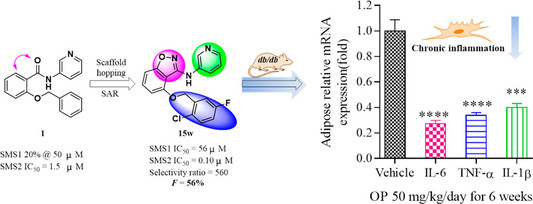
Sphingomyelin (SM) is the main component of phospholipids, which serve as central regulators in various physiological pathways such as cell proliferation, cell death and apoptosis, and intracellular trafficking. SM distributes mainly in the membrane and is synthesized by sphingomyelin synthase 1/2 (SMS1/2). The adjunct professor Xiancheng Jiang of our school from Downstate Medical Center, State University of New York, found that dynamic modification of SM in SMS2 knockout mice could be protected from diet-induced obesity, fatty liver, type 2 diabetes mellitus (T2DM), and insulin resistance with few negative side effects. Sphingomyelin synthase 2 (SMS2) is a promising therapeutic target for several chronic inflammation-associated diseases, including atherosclerosis, fatty liver, and insulin resistance. However, the lack of specific SMS2 inhibitors hampers the development of pharmacological studies of SMS2 inhibitors in vitro and in vivo.
Recently, Prof. Ye’s group reported the identification of 4-benzyloxybenzo[d]isoxazole-3-amine derivatives as potent and highly selective SMS2 inhibitors in Journal of Medicinal Chemistry titled with “Discovery of 4-benzyloxybenzo[d]isoxazole-3- amine derivatives as highly selective and orally efficacious human sphingomyelin synthase 2 inhibitors that reduce chronic inflammation in db/db Mice”( https://pubs.acs.org/doi/10.1021/acs.jmedchem.8b00727). Compound 15w is a selective SMS2 inhibitor, which not only attenuated significantly chronic inflammation, but also improved lipid metabolism disorders in db/db mice after oral dosing for 6 weeks, such as attenuation of IL-6 levels in serum, reduction of mRNA levels of IL-6, IL-1β, TNF-α in liver and adipose tissues and improvement of TG,TC LDL-C and NEFA levels.

This study provides a foundation to further develop selective SMS2 inhibitors. The data suggested that selective SMS2 inhibitors maybe an alternative potential therapeutic agents for treatment of chronic inflammation and lipid metabolism disorder associated disease.
The first author is doctoral candidate Mingguang Mo, and corresponding authors are Prof. Deyong Ye and A.P. Lu Zhou.